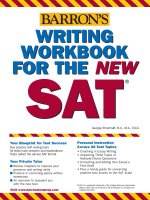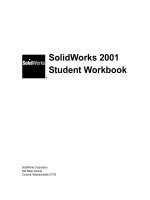Student workbook for phlebotomy essentials 5e 2012
Bạn đang xem bản rút gọn của tài liệu. Xem và tải ngay bản đầy đủ của tài liệu tại đây (5.5 MB, 290 trang )
Student Workbook for
Essentials
Fifth Edition
Ruth E. McCall, BS, MT (ASCP)
Retired Program Director and Instructor
Central New Mexico Community College
Albuquerque, New Mexico
Cathee M. Tankersley, BS, MT (ASCP)
President, NuHealth Educators, LLC
Faculty, Emeritus
Phoenix College
Phoenix, Arizona
LWBK706-FM_pi-x.indd i
11/24/10 8:22:33 PM
Acquisitions Editor: Peter Sabatini
Product Manager: Meredith L. Brittain
Marketing Manager: Shauna Kelley
Designer: Holly McLaughlin
Production Services: Aptara, Inc.
Fifth Edition
Copyright © 2012, 2008 by Lippincott Williams & Wilkins, a Wolters Kluwer business.
351 West Camden Street
Baltimore, MD 21201
Two Commerce Square
2001 Market Street
Philadelphia, PA 19103
Printed in China
All rights reserved. This book is protected by copyright. No part of this book may be reproduced or transmitted in any form or by any
means, including as photocopies or scanned-in or other electronic copies, or utilized by any information storage and retrieval system
without written permission from the copyright owner, except for brief quotations embodied in critical articles and reviews. Materials
appearing in this book prepared by individuals as part of their official duties as U.S. government employees are not covered by the abovementioned copyright. To request permission, please contact Lippincott Williams & Wilkins at Two Commerce Square, 2001 Market Street,
Philadelphia, PA 19103, via email at , or via website at lww.com (products and services).
9 8 7 6 5 4 3 2 1
DISCLAIMER
Care has been taken to confirm the accuracy of the information present and to describe generally accepted practices. However, the authors,
editors, and publisher are not responsible for errors or omissions or for any consequences from application of the information in this book
and make no warranty, expressed or implied, with respect to the currency, completeness, or accuracy of the contents of the publication.
Application of this information in a particular situation remains the professional responsibility of the practitioner; the clinical treatments
described and recommended may not be considered absolute and universal recommendations.
The authors, editors, and publisher have exerted every effort to ensure that drug selection and dosage set forth in this text are in
accordance with the current recommendations and practice at the time of publication. However, in view of ongoing research, changes in
government regulations, and the constant flow of information relating to drug therapy and drug reactions, the reader is urged to check
the package insert for each drug for any change in indications and dosage and for added warnings and precautions. This is particularly
important when the recommended agent is a new or infrequently employed drug.
Some drugs and medical devices presented in this publication have U.S. Food and Drug Administration (FDA) clearance for limited use
in restricted research settings. It is the responsibility of the healthcare provider to ascertain the FDA status of each drug or device planned
for use in their clinical practice.
To purchase additional copies of this book, call our customer service department at (800) 638-3030 or fax orders to (301) 223-2320.
International customers should call (301) 223-2300.
Visit Lippincott Williams & Wilkins on the Internet: . Lippincott Williams & Wilkins customer service representatives
are available from 8:30 am to 6:00 pm, EST.
LWBK706-FM_pi-x.indd ii
11/24/10 11:44:07 AM
To all the students whom we have had the privilege of teaching and
who have made our teaching careers worthwhile.
RUTH E. McCALL
CATHEE M. TANKERSLEY
LWBK706-FM_pi-x.indd iii
11/24/10 11:44:07 AM
LWBK706-FM_pi-x.indd iv
11/24/10 11:44:07 AM
Preface
Student Workbook for Phlebotomy Essentials, fifth edition, is designed to be used in combination with the fifth edition of the Phlebotomy Essentials textbook as a valuable learning
resource that will help the student master the principles of phlebotomy by reinforcing key
concepts and procedures covered in the textbook. The workbook offers a variety of exercises
and tools to make it easy and fun for the student to understand and remember essential
information and enhance critical-thinking skills.
Some exercises require written answers to provide spelling practice in addition to testing
knowledge. Every chapter includes:
• Chapter Objectives that correspond to those in the companion textbook
• Matching Activities including Key Term Matching
• Labeling Activities to help students visualize important material
• Knowledge Drills including fun scrambled word activities
• Skills Drills, including requisition and procedure practice activities
• Chapter and Unit Crossword Puzzles to help make learning fun
• Chapter Review Questions to test comprehension of chapter material
• Case Studies to bring concepts to life
Answers to all workbook activities and exercises are located in the Faculty Resource Center
at Access to these answers is strictly limited
to faculty only. If you have further questions concerning this workbook, please email
The authors sincerely wish to express their gratitude to all who assisted in and supported
this effort.
RUTH E. McCALL
CATHEE M. TANKERSLEY
v
LWBK706-FM_pi-x.indd v
11/24/10 11:44:07 AM
LWBK706-FM_pi-x.indd vi
11/24/10 11:44:08 AM
Reviewers
Diana Alagna, RN, RMA
Program Director
Medical Assisting
Branford Hall Career Institute
Southington, Connecticut
Kathleen Finnegan, MS, MT (ASCP),
SH
Clinical Associate Professor and Chair
Clinical Laboratory Sciences
Stony Brook University
Stony Brook, New York
Gerry Brasin, AS, CMA (AAMA), CPC
Coordinator
Education/Compliance
Premier Education Group
Springfield, Massachuesetts
Tammy Gallagher, BS, MT
Konnie Briggs, LN
Henry Gomez, MD
Instructor
Health Science
Houston Community College
Houston, Texas
Associate Professor
Division of Health Disciplines
ASA Institute
Brooklyn, New York
Lou Brown, BS, MT (ASCP),
CMA (AAMA)
Cheryl Milish, AAS
Program Director
Medical Assisting and Phlebotomy
Wayne Community College
Goldsboro, North Carolina
Medical Technologist
Butler County Community College
Butler, Pennsylvania
Instructor
Allied Health
Southwestern College
Florence, Kentucky
Judith Miller, BS, MT (ASCP)
Susen Edwards, MA
Program Coordinator
Allied Health
Middlesex County College
Edison, New Jersey
Clinical Coordinator
Medical Laboratory Technician Program
Barton County Community College
Great Bend, Kansas
Lane Miller, MBA/HCM
Lance Everett, BA, CPT
Director
Allied Health
National Career Education
Rancho Cordova, California
Director
Continuing Education
Medical Careers Institute
Virginia Beach, Virginia
Nancy Feulner, MS Ed
Carole Mullins, BS, MT (ASCP), MPA,
DLM (ASCP)
Program Coordinator
Health Science
College of DuPage
Glen Ellyn, Illinois
Adjunct Faculty
Nursing and Human Services
Southwestern Michigan College
Dowagiac, Michigan
vii
LWBK706-FM_pi-x.indd vii
11/24/10 11:44:08 AM
viii
REVIEWERS
Michael Murphy, CMA (AAMA)
Barbara Vaiden, BS, MT (ASCP)
Program Coordinator
Berdan Institute at The Summit Medical
Group
Union, New Jersey
Supervisor
Phlebotomy
OSF Saint Anthony Medical Center
Rockford, Illinois
Debbie Reasoner, (NHA)-CPT-CHI
Nicole Walton, PBT, RMA
Director and Instructor
Phlebotomy/Lab Assistant
West Coast Phlebotomy, Inc.
Oregon City, Oregon
Phlebotomy Instructor
Center for Workforce Development
College of Western Idaho
Boise, Idaho
Marie Thomas, CLT, CMA
Clinical Instructor/Lead
Medical Assisting
Berdan Institute
Wayne, New Jersey
LWBK706-FM_pi-x.indd viii
11/24/10 11:44:09 AM
Contents
Preface v
Reviewers vii
UNIT I INTRODUCTION TO PHLEBOTOMY IN HEALTHCARE 1
1 Phlebotomy: Past and Present and the Healthcare Setting 1
2 Quality Assurance and Legal Issues 19
3 Infection Control, Safety, First Aid, and Personal Wellness 37
UNIT I CROSSWORD EXERCISE
55
UNIT II OVERVIEW OF THE HUMAN BODY 57
4 Medical Terminology 57
5 Human Anatomy and Physiology Review 69
6 The Circulatory System 95
UNIT II CROSSWORD EXERCISE
115
UNIT III BLOOD COLLECTION PROCEDURES 117
7 Blood Collection Equipment, Additives, and Order of Draw 117
8 Venipuncture Specimen Collection Procedures 133
9 Preanalytical Considerations 157
10 Capillary Puncture Equipment and Procedures 177
UNIT III CROSSWORD EXERCISE
196
ix
LWBK706-FM_pi-x.indd ix
11/24/10 11:44:09 AM
x
CONTENTS
UNIT IV SPECIAL PROCEDURES 197
11 Special Collections and Point-of-Care Testing 197
12 Computers and Specimen Handling
and Processing
221
13 Nonblood Specimens and Tests 237
14 Arterial Puncture Procedures 257
UNIT IV CROSSWORD EXERCISE
LWBK706-FM_pi-x.indd x
275
11/24/10 11:44:09 AM
UNIT I
INTRODUCTION TO PHLEBOTOMY
IN HEALTHCARE
CHAPTER
1
Phlebotomy: Past and Present
and the Healthcare Setting
OBJECTIVES
Study the
information in
your textbook
that corresponds
to each objective
to prepare
yourself for the
activities in this
chapter.
1
Define the key terms and abbreviations listed at the beginning of this chapter.
2
Describe the evolution of phlebotomy and the role of the phlebotomist in today’s
healthcare setting.
3
Describe the traits that form the professional image and identify national
organizations that support professional recognition of phlebotomists.
4
Describe the basic concepts of communication as they relate to healthcare and how
appearance and nonverbal messages affect the communication process.
5
Describe proper telephone protocol in a laboratory and other healthcare settings.
6
Demonstrate an awareness of the different types of healthcare settings.
7
Compare types of third-party payers, coverage, and methods of payment to the
patient, provider, and institutions.
8
Describe traditional hospital organization and identify the healthcare providers in the
inpatient facility.
9
List the clinical analysis areas of the laboratory and the types of laboratory
procedures performed in the different areas
10 Describe the different levels of personnel found in the clinical laboratory and how
the regulations of the Clinical Laboratory Improvement Amendment affect their job
descriptions.
1
LWBK706_WBCh01_p01-18.indd 1
11/24/10 11:36:49 AM
2
UNIT I: INTRODUCTION TO PHLEBOTOMY IN HEALTHCARE
Matching
Use choices only once unless otherwise indicated.
MATCHING 1-1: KEY TERMS AND DESCRIPTIONS
Match the key term with the best description.
Key Terms (1–15)
1. _____ AHCCCS
2. _____ APC
3. _____ certification
4. _____ CLIA ‘88
5. _____ communication barriers
6. _____ CMS
7. _____ CPT
8. _____ case manager
9. _____ exsanguinate
10. _____ HIPAA
11. _____ HMOs
12. _____ ICD-9-CM
Descriptions
A. Evidence that an individual has mastered fundamental competencies in a
technical specialty
B. Health Insurance Portability and Accountability Act
C. Ambulatory patient classification
D. Experienced HC professional that serves as the patient’s advocate and
adviser
E. Verbal and nonverbal messages do not match
F. Health maintenance organizations
G. Arizona Health Care Cost Containment System
H. Current procedural terminology codes
I. Biases that are major obstructions to verbal communication.
J. International Classification of Diseases, 9th Revision, Clinical Modification
K. Clinical Laboratory Improvement Amendments of 1988
L. Remove all blood
M. Centers for Medicare and Medicaid Services
N. Integrated healthcare delivery system
O. Study of nonverbal communication
13. _____ IDS
14. _____ kinesic slip
15. _____ kinesics
Match the key term with the best description.
Key Terms (16–30)
Descriptions
16. _____ MCOs
A. Care by physician who assumes ongoing responsibility for maintaining
patients’ health.
B. Care by specialist who can perform out-of-the-ordinary procedures in
outpatient facilities
C. More recent term meaning venesection
D. Disorder involving overproduction of red blood cells
E. Highly complex care from practitioners in a hospital or overnight facility
F. Managed care organizations
G. Federally funded program that provides healthcare to seniors, 65 and older
H. Promotes and administers programs for public health
I. Federal and state program that provides medical assistance for eligible
low-income Americans
J. Insurance company that pays for healthcare services on behalf of a
patient
K. Preferred provider organizations
L. Study of an individual’s concept and use of space
M. Large, independent laboratories that test specimens from many different
facilities
N. Medical Laboratory Scientist
O. Protected health information
17. _____ Medicaid
18. _____ Medicare
19. _____ MLS
20. _____ PHI
21. _____ PHS
22. _____ phlebotomy
23. _____ polycythemia
24. _____ PPOs
25. _____ primary care
26. _____ proxemics
27. _____ reference laboratories
28. _____ secondary care
29. _____ tertiary care
30. _____ third-party payer
LWBK706_WBCh01_p01-18.indd 2
11/24/10 11:36:49 AM
3
CHAPTER 1: PHLEBOTOMY: PAST AND PRESENT AND THE HEALTHCARE SETTING
MATCHING 1-2: CERTIFICATION AGENCIES
Match the certification agency with the title awarded. A title may be used more than once.
Certification Agency
Title Awarded
1. _____ American Society of Clinical Pathologists
A.
B.
C.
D.
2. _____ American Medical Technologists
3. _____ National Center for Competency Testing
RPT
CPT
PBT
NCPT
4. _____ American Certification Agency
5. _____ National Healthcareer Association
MATCHING 1-3: METHODS OF PAYMENT AND DIAGNOSIS CODING
Match the methods of payment and diagnosis coding with the appropriate definition.
Method of Payment and Diagnosis Coding
Definitions
1. _____ Ambulatory patient classification
A. Begun in 1983 to limit and standardize the
Medicare/Medicaid payments made to hospitals
B. Reimburses healthcare facilities a set amount for
each patient procedure using established disease
categories
C. A classification system implemented in 2000 for
determining payment to hospitals for outpatient
service
D. All major payers use this coding system, which
groups together similar disease and operations for
reimbursement
2. _____ International Classification of Diseases,
9th Revision
3. _____ Prospective payment system
4. _____ Diagnosis-related groups
MATCHING 1-4: LABORATORY TESTS AND DEPARTMENTS
Match the laboratory tests with the departments that perform them. Departments can be used more than one time.
Laboratory Tests
1. _____ BMP
2. _____ PT
3. _____ Hct
4. _____ WBC diff
5. _____ Nitrites
6. _____ ANA
7. _____ Specific gravity
8. _____ ALT
9. _____ D-dimer
10. _____ Triglycerides
LWBK706_WBCh01_p01-18.indd 3
11. _____ Blood culture
12. _____ EBV
13. _____ Type and Rh
14. _____ Gram stain
15. _____ DAT
16. _____ Troponin
17. _____ Bilirubin
Laboratory Departments
A.
B.
C.
D.
E.
F.
G.
H.
I.
Hematology
Blood Bank
Coagulation
Chemistry
Immunology
Urinalysis
Microbiology
Histology
Cytology
18. _____ APTT
19. _____ Plt ct
20. _____ Glucose
11/24/10 11:36:49 AM
4
UNIT I: INTRODUCTION TO PHLEBOTOMY IN HEALTHCARE
MATCHING 1-5: PATIENT CONDITIONS AND MEDICAL SPECIALTIES
Match the specialties with types of patient conditions they serve.
Patient Conditions
1. _____ Tumors, benign and malignant
2. _____ Eye examinations
3. _____ Endocrine gland disorders
4. _____ Diseases of the heart
5. _____ Disorders of the brain and spinal cord
6. _____ Well checkups for children
7. _____ Kidney function
8. _____ Urinary tract disease
9. _____ Conditions of the skin
10. _____ Age-related disorders
11. _____ Digestive tract disorders
Medical Specialties
A. Anesthesiology
B. Cardiology
C. Dermatology
D. Endocrinology
E. Gastroenterology
F. Gerontology
G. Hematology
H. Infectious Diseases
I. Nephrology
J. Neurology
K. Oncology
M. Ophthalmology
N. Pediatrics
O. Psychiatry
P. Pulmonary Medicine
Q. Rheumatology
12. _____ Respiratory system conditions
13. _____ Inflammation and joint diseases
14. _____ Contagious, pathogenic infections
15. _____ Disorders of the blood
LWBK706_WBCh01_p01-18.indd 4
11/24/10 11:36:50 AM
CHAPTER 1: PHLEBOTOMY: PAST AND PRESENT AND THE HEALTHCARE SETTING
5
Labeling Exercises
LABELING 1-1: VERBAL COMMUNICATION BARRIERS
Using the TEXTBOOK, identify each HCW communication barrier in the numbered boxes on the left of the communication feedback loop diagram and each “Client” communication barrier on the right. Write the answers in
the corresponding blanks below the diagram.
REACTION
1
FEEDBACK
2
10
9
MESSAGE
HEALTHCARE
WORKER
3
CLIENT
5
6
4
8
7
REACTION
FEEDBACK
1. ____________________________________________
6. ____________________________________________
____________________________________________
____________________________________________
2. ____________________________________________
7. ____________________________________________
____________________________________________
____________________________________________
3. ____________________________________________
8. ____________________________________________
____________________________________________
____________________________________________
4. ____________________________________________
9. ____________________________________________
____________________________________________
____________________________________________
5. ____________________________________________
10. ____________________________________________
____________________________________________
____________________________________________
LWBK706_WBCh01_p01-18.indd 5
11/24/10 11:36:50 AM
6
UNIT I: INTRODUCTION TO PHLEBOTOMY IN HEALTHCARE
LABELING 1-2: NONVERBAL FACIAL CUES
Label each of the sketches below with the correct facial cue from the following list:
• Surprise
• Fear
• Sad
• Happy
• Anger
A.
B.
C.
• Disgust
D.
E.
F.
G.
H.
I.
LABELING 1-3: HOSPITAL ORGANIZATIONAL CHART
Fill in the names of the major divisions in a typical hospital organizational chart.
BOARD OF DIRECTORS
CHIEF OF MEDICAL
STAFF
PRESIDENT AND CEO
1
Case
Management
Patient
Representative
Infection
Control
Performance
Improvement
2
Director Laboratory
Director Medical
Imaging
Director Pulmonary/
Respiratory &
Endoscopy
Services
Director
Cardiovascular
Services
3
4
Director Women’s &
Children’s Services
Director
Volunteers
Director Pediatrics &
NICU
Interim Director
Foundation
Interim Director
ICU/Tele
Retail Services Gift Shop, ATM,
Coffee Shop,
Sandwich Shop,
Florist
Director Perioperative
Services
5
6
Administrator
Physician
Services
Medical Director
Trauma
Manager Medical
Staff Services
Director Emergency &
Trauma Services
Director Pharmacy
Director Guest
Services
Director Physical
Medicine & Rehab
Director Education &
Workforce Development
Director Medical
Surgical Services/
Dialysis Services
Interim Manager Patient
Access Services
Hospital
Supervisors
1. __________________________________________________________________________________________________
2. __________________________________________________________________________________________________
3. __________________________________________________________________________________________________
4. __________________________________________________________________________________________________
5. __________________________________________________________________________________________________
6. __________________________________________________________________________________________________
LWBK706_WBCh01_p01-18.indd 6
11/24/10 11:36:50 AM
7
CHAPTER 1: PHLEBOTOMY: PAST AND PRESENT AND THE HEALTHCARE SETTING
Knowledge Drills
KNOWLEDGE DRILL 1-1: CAUTION AND KEY POINT RECOGNITION
The following sentences have been taken from caution and key point statements found throughout Chapter 1 of the
textbook. Using the TEXTBOOK, fill in the blanks with the missing information.
, the phlebotomist promotes (B)
1. By recognizing (A)
, the (D)
relationships that directly improve health (C)
and (E)
of services,
relations.
is such an (B)
2. Maintaining (A)
issue in testing for (C)
that
before the specimen for the test can be collected.
the patient must sign a (D)
3. To (A)
and harmonious
effectively with someone, it is important to establish good (B)
and more like an (D)
A patient or client may be made to (C)
.
rather than a
human being if no eye contact is established.
4. Phlebotomists will find that when dealing with (A)
(C)
who are (B)
, a confident and professional (D)
or
will be most (E)
to doing their job.
KNOWLEDGE DRILL 1-2: SCRAMBLED WORDS
Scrambled Words
1. deadmici
(healthcare for the poor)
2. enscikis
(involves body language)
3. fracitinecito
(an indication of competency)
4. gloomyheat
(lab area that counts blood cells)
5. irebrar
(message obstruction)
6. mexicrops
(involves one’s concept of space)
7. ratyitre
(highly complex care)
8. shymictre
(most lab tests are this type)
9. sneeviconte
(phlebotomy)
10. troblumaya
(describes most outpatients)
KNOWLEDGE DRILL 1-3: HISTORICAL PHLEBOTOMY EVENTS
Number the following events in chronological order from 1 through 5, with 1 being the earliest recorded event.
a. _____ The French used leeching for localized bloodletting.
b. _____ “Short robe” surgeons used cupping and leeching to extract blood.
c. _____ Microsurgeons use leeching to lessen the complications of surgery.
d. _____ Hippocrates used bloodletting to cleanse the body of impurities.
e. _____ Physicians used a procedure called venesection to treat George Washington.
LWBK706_WBCh01_p01-18.indd 7
11/24/10 11:36:50 AM
8
UNIT I: INTRODUCTION TO PHLEBOTOMY IN HEALTHCARE
KNOWLEDGE DRILL 1-4: INPATIENT/OUTPATIENT FACILITY
Write the correct category (outpatient or inpatient) of healthcare facility in the line provided before the statement
description.
1.
Principal source of healthcare services for most people
2.
Highly complex services
3.
Requires that patients stay overnight or longer
4.
Center of the American healthcare system
5.
Same-day surgical procedures
6.
Physician’s office care
KNOWLEDGE DRILL 1-5: MEDICARE/MEDICAID PROGRAMS
Write the correct program name (Medicare or Medicaid) in the line provided before the statement description.
1.
Funds come from federal grants
2.
An entitlement program
3.
Provides medical assistance to the poor
4.
Program administered by the state
5.
Benefits divided into two sections: Part A and Part B
6.
Financed through social security deductions
KNOWLEDGE DRILL 1-6: PROFESSIONAL ATTITUDE
After each characteristic listed below, define and describe how this quality contributes to your professional attitude:
a. Self-confidence
b. Self-motivation
c. Compassion
d. Dependability
e. Ethical behavior
f. Integrity
LWBK706_WBCh01_p01-18.indd 8
11/24/10 11:36:50 AM
9
CHAPTER 1: PHLEBOTOMY: PAST AND PRESENT AND THE HEALTHCARE SETTING
Skills Drills
SKILLS DRILL 1-1: REQUISITION ACTIVITY
Instructions: A test requisition contains the following test abbreviations. Write the complete name of the test and
the department that will perform the test on the corresponding line next to the abbreviation.
Any Hospital USA
1123 West Physician Drive
Any Town USA
Laboratory Test Requisition
PATIENT INFORMATION:
Name:
Smith
Jane
R
(last)
(first)
(MI)
Identification Number:
09365784
Referring Physician:
Coleman
Date to be Collected:
03/11/11
Special Instructions:
Birth Date: 06/21/63
Time to be Collected:
0600
line draw only
TEST(S) REQUIRED:
TEST
ABBREVIATION
TEST NAME
DEPARTMENT
1. RBC
2. Hgb
3. FDP
4. LD
5. PT
6. CBC
7. CEA
8. RPR
9. UA
10. C&S
LWBK706_WBCh01_p01-18.indd 9
11/24/10 11:36:50 AM
10
UNIT I: INTRODUCTION TO PHLEBOTOMY IN HEALTHCARE
SKILLS DRILL 1-2: WORD BUILDING (See Chapter 4, Medical Terminology)
Divide each of the words below into all of its elements (parts): prefix (P), word root (WR), combining vowel (CV),
and suffix (S). Write the word part, its definition, and the meaning of the word on the corresponding lines.
If the word does not have a particular element, write NA (not applicable) in its place.
Example: pathology
Elements
/
P
Definitions
path
/
WR
/
disease
o
/
CV
/
logy
S
/
study of
Meaning: study of disease
1. nephrology
Elements
___________________ /__________________ /________ /___________ ________
P
Definition
WR
CV
S
___________________ /__________________ /________ /__________ __ ______
Meaning:
2. phlebotomy
Elements
___________________ /__________________ /________ /____________________
P
Definition
WR
CV
S
___________________ /__________________ /________ /____________________
Meaning:
3. polycythemia
Elements
___________________ /__________________ /________ /____________________
Definition
___________________ /__________________ /________ /____________________
P
WR
CV
S
Meaning:
4. hematology
Elements
___________________ /__________________ /________ /____________________
P
Definition
WR
CV
S
___________________ /__________________ /________ /____________________
Meaning:
5. erythrocyte
Elements
___________________ /__________________ /________ /____________________
P
Definition
WR
CV
S
___________________ /__________________ /________ /____________________
Meaning:
6. dermatologist
Elements
___________________ /___________________ /_______ /____________________
P
Definition
WR
CV
S
___________________ /___________________ /_______ /____________________
Meaning:
LWBK706_WBCh01_p01-18.indd 10
11/24/10 11:36:50 AM
11
CHAPTER 1: PHLEBOTOMY: PAST AND PRESENT AND THE HEALTHCARE SETTING
SKILLS DRILL 1-3: PROPER TELEPHONE ETIQUETTE
Fill in the blanks of the following table with the missing information.
Proper Etiquette
Communication Tips
Answer
(1)
Rationale
• If the phone is allowed to ring too many times, the
.
caller may assume that the people working in the
laboratory are inefficient or (2)______________.
State your name and
• The caller has a right to know to whom he or she is
department.
speaking.
Ask how you can be of help to
Be helpful.
• When a phone rings, it is because someone needs
(3) ______________ and facili-
something. Because of the nature of the healthcare
tate the conversation.
business, the caller may be (4) ______________ and
Keep your statements and an-
may benefit from hearing a calm, pleasant voice at
swers simple and to the point
the other end
so as to avoid confusion.
(5)
Inform a caller whose call is
calls.
interrupting one from someone
else.
Always ask permission before
• It takes an organized person to coordinate several
calls.
• The caller should be informed if he or she is interrupting another call.
putting a caller on hold in
case it is an (6) _________ that
must be handled immediately
Transfer and
Tell a caller when you are go-
(7)
ing to transfer the call or put
.
it on hold and learn how to do
• Disconnecting callers while transferring or putting
them on hold (8) ___________________________.
• Leaving the line open so that other conversations can
this properly.
be heard by the person on hold is discourteous and
Note: Do not leave the line
can compromise (9) __________________.
open and do not keep the
caller waiting too long.
• (10) __________________ with a caller when on
hold for longer than expected; this keeps him or her
informed of the circumstance.
• If a caller is waiting on hold too long, ask if he or
she would like to leave a message.
Be prepared to re-
Have a pencil and paper close
cord information.
to the phone.
phone at work to ensure that (13)________________
(11) ____________________,
information is transmitted to the necessary person.
which means clarifying, (12)
• Reading back the information when complete is one
___________, and summarizing
• Documentation is necessary when answering the
of best ways to (14)___________ it is correct.
the information received.
LWBK706_WBCh01_p01-18.indd 11
11/24/10 11:36:50 AM
12
UNIT I: INTRODUCTION TO PHLEBOTOMY IN HEALTHCARE
Proper Etiquette
Communication Tips
Rationale
Know the labora-
Make answers consistent by
• People who answer the telephone must know the
tory’s policies.
learning the laboratory’s
(15) _______________ to avoid giving the wrong
policies.
information.
• (16) _______________ help establish the laboratory’s
credibility, because a caller’s perception of the lab
involves more than just accurate test results.
Defuse
When a caller is hostile, you
(17)
might say “I can see why you
situations.
are upset. Let me see what I
can do.”
• Some callers become angry because of lost results or
errors in billing.
• (18) _____________ a hostile caller’s
(19) ___________ will often defuse the situation.
• After the caller has calmed down, the issue can be
addressed.
Try to assist every-
If you are uncertain, refer the
one.
caller to someone who can
__________ even if you are not actually answering
address the caller’s issue.
their questions.
Remind yourself to keep your
attention on (23) ___________
______________ at a time.
• It is possible to assist callers and (20) _____________
• Validate callers’ requests by giving a response
that tells them (21) _________________________.
• (22) __________________ in the caller will enhance
communication and contribute to the good (24)
_____________ of the laboratory.
LWBK706_WBCh01_p01-18.indd 12
11/24/10 11:36:50 AM
13
CHAPTER 1: PHLEBOTOMY: PAST AND PRESENT AND THE HEALTHCARE SETTING
SKILLS DRILL 1-4: TWO CATEGORIES OF HEALTHCARE FACILITIES
Outpatient
Inpatient
• (1) ________________ of healthcare services for most
• The key resource and (2) _____________ of the
people.
• Offer (3) ______________ care in physician’s office to
(4) ________________ care in a freestanding ambula-
American healthcare system.
• Offer specialized instrumentation and technology to
assist in unusual diagnoses and treatments.
tory setting.
• Serve (5) ________________ physicians who assume
• Serve (6) _______________ (highly complex services
(7) ______________ responsibility for maintaining
and therapy) practitioners. Usually requires that
patients’ health.
patients stay overnight or longer.
• Serve (8) ________________ physicians (specialists)
• Examples are acute care hospitals, nursing homes,
who perform routine surgery, (10) ________________
(9) _______________, hospices, and rehabilitation
treatments, therapeutic radiology, and so on in
centers.
same-day service centers.
LWBK706_WBCh01_p01-18.indd 13
11/24/10 11:36:50 AM









